



A clamshell is a one-piece container consisting of two halves joined by a hinge area which allows the structure to come together to close. Clamshells can be made to be reusable and reclosable [1] or can be sealed securely.




A clamshell is a one-piece container consisting of two halves joined by a hinge area which allows the structure to come together to close. Clamshells can be made to be reusable and reclosable [1] or can be sealed securely.
Containers acting similar to clamshells have been widely used for many years, constructed from a diversity of materials. Patent Classification B65D43/162 covers “Non-removable lids or covers hinged for upward or downward movement the container, the lid and the hinge being made of one piece". It lists over ten thousand patents in the last hundred years. [2]
Foam plastic clamshells have been used in fast food restaurants for burgers; paperboard clamshells are currently being used similarly. Clear plastic clamshell containers were used for strawberries by Driscoll’s, a California berry grower, in the 1990s to pack its berries for retail sale. [3]
Clamshell containers can be made of a variety of materials. Plastics such as polystyrene, polyester, PVC, foam sheets, etc. The material can be made by thermoforming or can be injection molded into the desired shapes. A single piece of material is used for the top and bottom with a "living hinge" that is integral to the material, rather than added separately.
Folding cartons made of paperboard or molded pulp can also be of a clamshell shape. [4] It can also be made of cellulose fiber such as sugarcane-bagasse, wheatstraw, wood pulp, etc.
Clamshells can use a variety of means of closing or sealing. Some have self-locking tabs, snaps, or have a friction fit. Others use adhesive, pressure-sensitive tape, labels, staples, or are heat-sealed.
Many clamshell containers are easy to open, and reuse, by consumers. When plastic clamshell containers are securely heat sealed, they are tamper resistant and deter package pilferage.
These security packages are intentionally difficult to open, sometimes requiring customers to use scissors or a knife.
Difficulty opening such packaging can be frustrating to the point of wrap rage. [5] Some people injure themselves trying to open security packaging which in the United Kingdom has been cited as the most frustrating to open. [6]

A bottle cap or bottle top is a closure for the top opening of a bottle. A cap is sometimes colorfully decorated with the logo of the brand of contents. Plastic caps are used for plastic bottles, while metal with plastic backing is used for glass; plastic caps are commonly made from polyethylene or polypropylene, while metal caps are usually either steel or aluminum. Plastic caps may have a pour spout. Flip-Top caps like Flapper closures provide controlled dispensing of dry products. Caps for plastic bottles are often made of a different type of plastic from the bottle.

A drum is a cylindrical shipping container used for shipping bulk cargo. Drums can be made of steel, dense paperboard, or plastic, and are generally used for the transportation and storage of liquids and powders. Drums are often stackable, and have dimensions designed for efficient warehouse and logistics use. This type of packaging is frequently certified for transporting dangerous goods. Proper shipment requires the drum to comply with all applicable regulations.

A carton is a box or container usually made of liquid packaging board, paperboard and sometimes of corrugated fiberboard. Many types of cartons are used in packaging. Sometimes a carton is also called a box.

A closure is a device used to close or seal a container such as a bottle, jug, jar, tube, or can. A closure may be a cap, cover, lid, plug, liner, or the like. The part of the container to which the closure is applied is called the finish.

A coffee cup is a container, a cup, for serving coffee and coffee-based drinks. There are three major types: conventional cups used with saucers, mugs used without saucers, and disposable cups. Cups and mugs generally have a handle. Disposable paper cups used for take-out sometimes have fold-out handles, but are more often used with an insulating coffee cup sleeve.

A living hinge or integral hinge is a thin flexible hinge made from the same material as the two rigid pieces it connects.

A blister pack is any of several types of pre-formed plastic packaging used for small consumer goods, foods, and for pharmaceuticals.
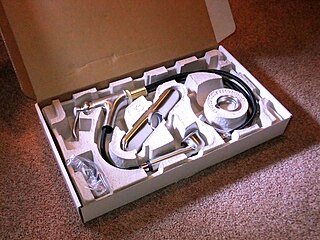
Molded pulp or molded fiber is a packaging material, that is typically made from recycled paperboard and/or newsprint. It is used for protective packaging or for food service trays and beverage carriers. Other typical uses are end caps, trays, plates, bowls and clamshell containers.

An egg carton is a carton designed for carrying and transporting whole eggs.

Package cushioning is used to protect items during shipment. Vibration and impact shock during shipment and loading/unloading are controlled by cushioning to reduce the chance of product damage.

A bulk box, also known as a bulk bin, skid box, pallet box, bin box, gaylord, or octabin, is a pallet-size box used for storage and shipping of bulk or packaged goods. Bulk boxes can be designed to hold many different types of items such as plastic pellets, watermelons, electronic components, and even liquids; some bulk boxes are stackable.
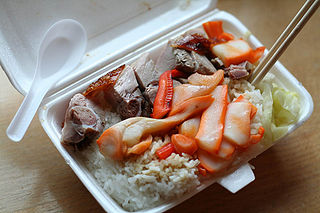
A foam food container is a form of disposable food packaging for various foods and beverages, such as processed instant noodles, raw meat from supermarkets, ice cream from ice cream parlors, cooked food from delicatessens or food stalls, or beverages like "coffee to go". They are also commonly used to serve takeout food from restaurants, and are also available by request for diners who wish to take home the remainder of their meal. The foam is a good thermal insulator, making the container easy to carry as well as keeping the food at the temperature it had when filled into the container, whether hot or cold.
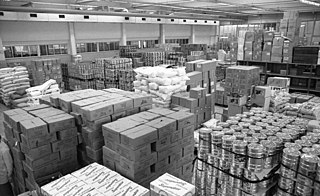
Food storage containers are widespread in use throughout the world and have probably been in use since the first human civilizations.

Disposable food packaging comprises disposable products often found in fast-food restaurants, take-out restaurants and catering establishments. Typical products are foam food containers, plates, bowls, cups, utensils, doilies and tray papers. These products can be made from a number of materials including plastics, paper, bioresins, wood and bamboo.
Ecologic Brands Inc. is a United States company that specializes in creating eco-friendly packaging solutions for consumer products. The products are made from sustainable materials and are designed to be recyclable or compostable. The company also provides branding and marketing services to help companies promote their environmentally conscious products.
Cardboard is a generic term for heavy paper-based products. The construction can range from a thick paper known as paperboard to corrugated fiberboard which is made of multiple plies of material. Natural cardboards can range from grey to light brown in color, depending on the specific product; dyes, pigments, printing, and coatings are available.

In technical usage in the shipping industry, a pail is a type of cylindrical shipping container with a capacity of about 3 to 50 litres. It can have straight or slanted sides and usually has a handle or bail.
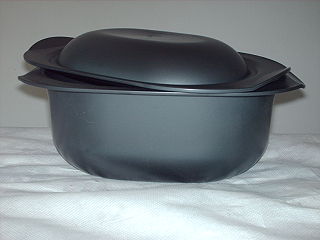
Plastic containers are containers made exclusively or partially of plastic. Plastic containers are ubiquitous either as single-use or reuseable/durable plastic cups, plastic bottles, plastic bags, foam food containers, Tupperware, plastic tubes, clamshells, cosmetic containers, up to intermediate bulk containers and various types of containers made of corrugated plastic. The entire packaging industry heavily depends on plastic containers or containers with some plastic content, besides paperboard and other materials. Food storage nowadays relies mainly on plastic food storage containers.
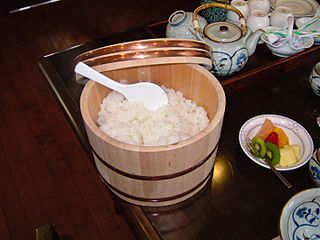
A tub is an open-top circular or oblong container. In earlier times they were made from wooden staves held together with iron hoops and were made by coopers. Modern tubs used in industry might be made from concrete, metal or plastic.

Closed Loop Box Reuse, is the process by which boxes or other containers are reused many times. It is a form of reusable packaging.